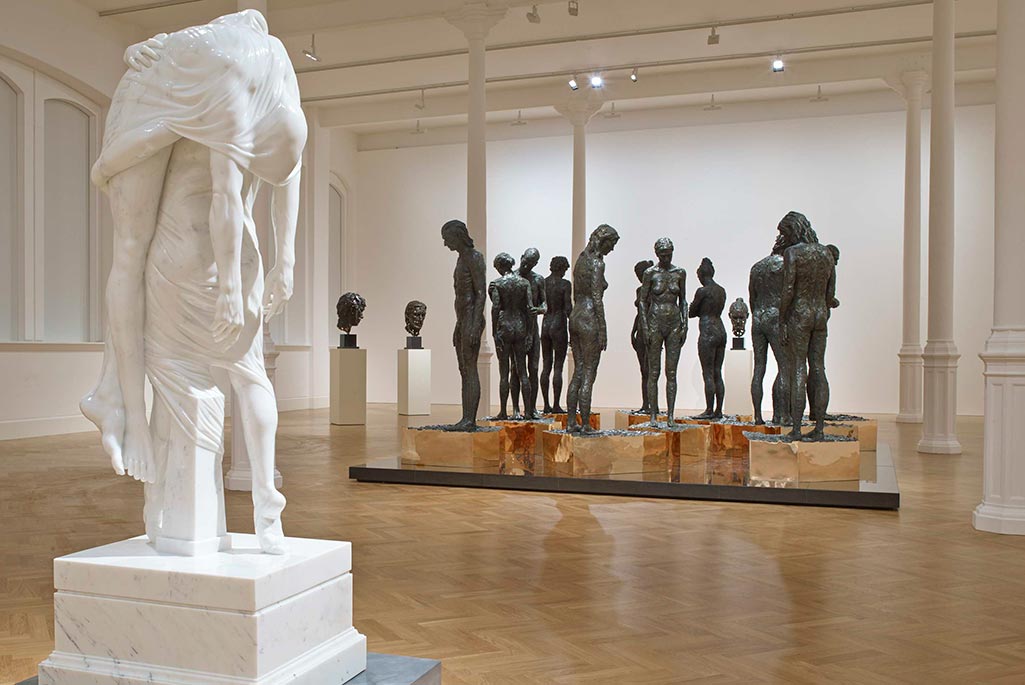Classical revivals are undergoing something of a revival. In Paris, the Musée D’Orsay is currently staging ‘Masculine/Masculine’, celebrating the legacy of classical art in representations of the male body (torqued, tortured, nobly nude) since 1800. The Yale Center for British Art, meanwhile, is preparing for a major survey of Victorian sculpture – a genre drenched in classical (or pseudo-classical) ideals – which will arrive at Tate Britain in 2015.
Even contemporary art is contributing to the neoclassical resurgence. At Pace Gallery, Northern Irish sculptor Kevin Francis Gray is exhibiting a series of new sculptures in bronze and marble, all of the human figure. They include Ballerina & Boy, a sinuous carving of a ballerina hoisting a drooping, Endymion-like youth over her shoulder. The pair is furled in a sheet reminiscent of Bernini’s floating drapery. Viewers might well wonder what century they are in.
I encounter Gray as he wanders amid a separate cluster of 12 life-sized bronze figures titled Twelve Chambers. He turns out to be sprightly and animated in a way that the grandeur of the work might not prepare you for. But perhaps the aura of classicism is also here a guise; the bodies in Twelve Chambers are scruffily textured and puny, the expressions downcast. We are hardly in the heroic world of the Riace bronzes. Each nude character is set on its own copper-clad pedestal, or ‘floating on its own island’, as Gray describes it, in an oblique allegory of political factions in Ireland. ‘The realm of the real is brutal and think and aggressive and angular’, Gray continues. ‘And that’s how I see people. I don’t see them as Herculean characters. These are people that actually exist.’
Increasingly, Gray’s ‘classicism’ is as close to that of Rodin as to older masters (Giuseppe Sanmartino’s Dead Christ and Stefano Maderno’s Saint Cecilia were both formative influences). Even so, Ballerina & Boy remains an unabashed celebration of neo-Baroque beauty, a swimming mass of weaving fabric and ogive bodies in polished white stone. It was hand-carved over a 10-month period by artisans in Italy after a model by Gray; the same family produce replicas for the Vatican of Bernini and Canova. ‘When I went first’, he recalls, ‘they were producing six Three Graces in one go, all by hand’. The effect is of marble has been poured as liquid into a mould – a kind of Carrara milk.
Gray is unperturbed by comparisons with classical art and its later incarnations: ‘I think that subconsciously, not only as creators but as visual people, we can’t avoid the romance of that era’, he explains. He recalls how visits as a teenager to Northern Ireland’s National Museums inculcated a ‘subconscious connection with classicism and romance’, adding that ‘the work does definitely reference certain periods of art history – it’s impossible not to – but I would like it to thread the boundary between contemporary society and classical history.’
Is this possible, I wonder, without being ironic. Ballerina & Boy seems almost audaciously Apolline, graceful and guileless. But Gray is unambiguous on this point: ‘A lot of collectors and a lot of museums who have been active in that much more “cardboard-and-masking-tape” sort of art, they’re now really focusing on the idea of quality. … The figure, all of a sudden in the last year, has become a big point of discussion, especially sculpturally. It’s not a movement, but there’s definitely a body of sculptors that are working in the figure.’
Ballerina & Boy may, however, be a swansong to a particular high-finish and aesthetic. ‘The aggression and tension and darkness of the piece is veiled’, Gray asserts, ‘literally and metaphorically veiled.’ He sees this show as a turning point, musing that ‘I am consciously moving away from direct figuration, and I want to move my work into more a discussion about abstraction based around the figure … a much more brutal way of working with the figure.’ The darker, Dionysian side of the classical seems set to be unveiled.
‘Kevin Francis Gray’ is at Pace Gallery, London, until 18 January 2014.






